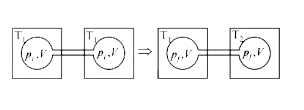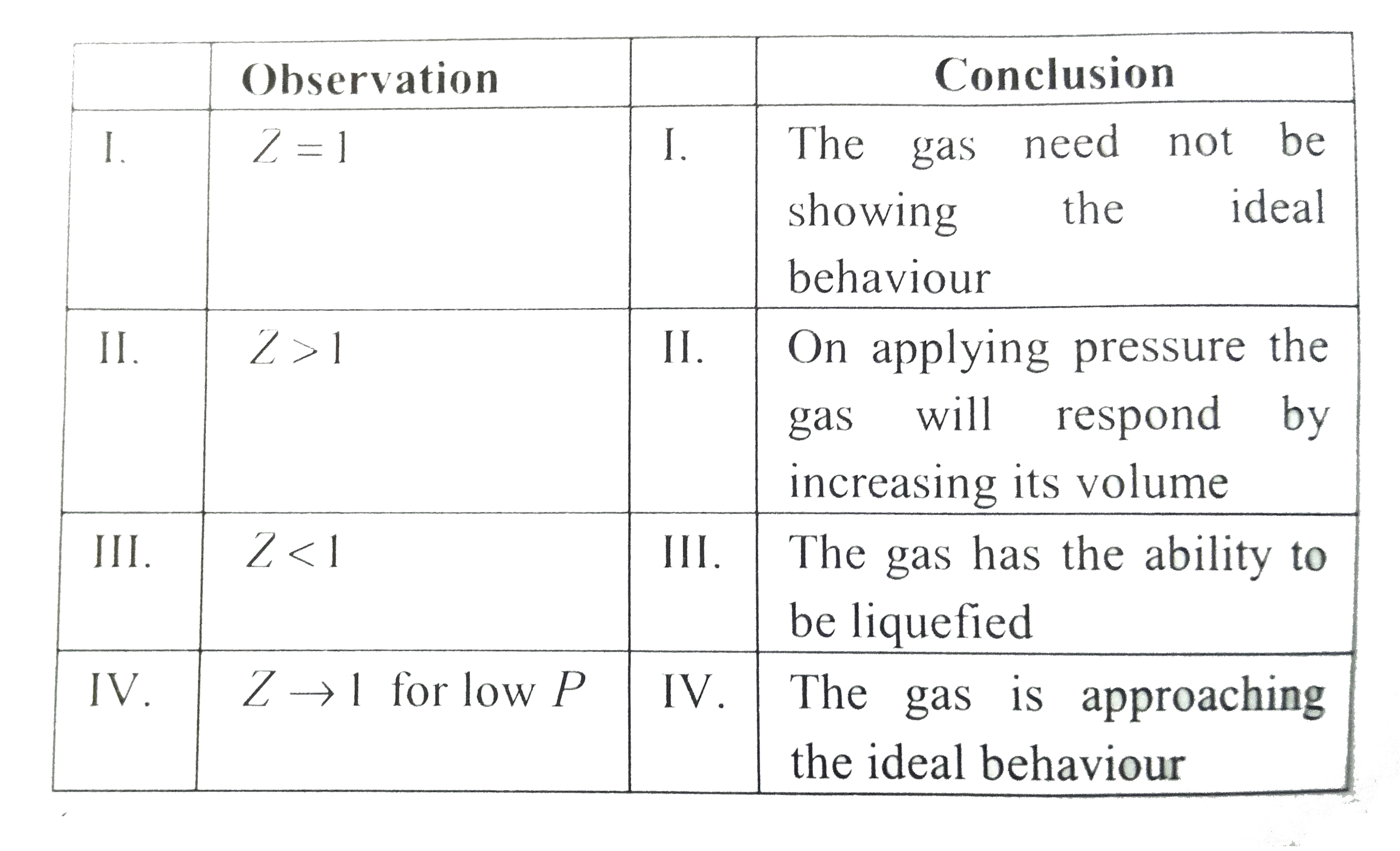JEE SECTION (Only one choice answer) from UNIVERSAL BOOK DEPOT 1960 CHEMISTRY (HINGLISH) GASEOUS STATE for Class 12
| Class 12 | CHEMISTRY |
| Chapter | GASEOUS STATE |
| UNIVERSAL BOOK DEPOT 1960 CHEMISTRY (HINGLISH) | JEE SECTION (Only one choice answer) |
| Medium | English |
| Academic Year | 2023-2024 |
Question 44
Two closed bulbs of equal volume (V) containing an ideal gas initially at pressure pi and temperature T1 are connected through a narrow tube of negligible volume as shown in the figure below. The temperature of one of the bulbs is then raised to T2. The final pressure pf is:
 View Solution
View SolutionQuestion 51
A open ended mercury manometer is used to measure the pressure exerted by a trapped gas as shown in the figure. Initially manometer shows no difference in mercury level in both columns as shown in diagram.

After sparking 'A' dissociates according to following reaction
A(g)→B(g)+3C(g)
If pressure of Gas "A" dissociates to 0.9 atm, then (Assume temperature to be constant and is 300 K)View SolutionQuestion 55
X and Y are two volatile liquids with molar weights of 10gmol−1 and 40gmol−1 respectively. Two cotton plugs, one soaked in X and the other soaked in Y, are simultaneously placed at the ends of a tube of length L=24 cm, as shown in the figure.
The tube is filled with an inert gas at 1 atm pressure and a temperature of 300K. Vapours of X and Y react to form a product whichh is first observed at a distance dcm from the plug soaked in X.
Take X and Y to have equal molecular diameters and assume ideal behaviour for the inert gas and two vapours.

The value of d in cm (shown in figure), as estimated from Graham's law, is View SolutionQuestion 56
X and Y are two volatile liquids with molar weights of 10gmol−1 and 40gmol−1 respectively. Two cotton plugs, one soaked in X and the other soaked in Y, are simultaneously placed at the ends of a tube of length L=24 cm, as shown in the figure.
The tube is filled with an inert gas at 1 atm pressure and a temperature of 300K. Vapours of X and Y react to form a product whichh is first observed at a distance dcm from the plug soaked in X.
Take X and Y to have equal molecular diameters and assume ideal behaviour for the inert gas and two vapours.

The value of d in cm (shown in figure), as estimated from Graham's law, is View SolutionQuestion 57
One of the approach to the study of real gases involves the analysis of a parameter Z called the compressibility factor Z=PVmRT where P is pressure, Vm is molar volume, T is absolute temperature and R is the universal gas constant . Such a relation can also be expressed as Z=(Vm realVm ideal) (where Vm ideal and Vm real are the molar volume for ideal and real gas respectively) . Gas corresponding Z>1 have repluive tendenciesamong constituent particles due to their size factor, among constitutent particles . As the pressure is lowered or temperature is increased the value of Z approaches 1. ( reaching the ideal behaviour)
For a real gas 'G'Z>1 at STP then for 'G' which of the following is trueView SolutionQuestion 58
One of the approach to the study of real gases involves the analysis of a parameter Z called the compressibility factor Z=PVmRT where P is pressure, Vm is molar volume, T is absolute temperature and R is the universal gas constant . Such a relation can also be expressed as Z=(Vm realVm ideal) (where Vm ideal and Vm real are the molar volume for ideal and real gas respectively) . Gas corresponding Z>1 have repluive tendenciesamong constituent particles due to their size factor, among constitutent particles . As the pressure is lowered or temperature is increased the value of Z approaches 1. ( reaching the ideal behaviour)
Following graph represents a pressure (P ) volume (V ) relationship at a fixed temperature (T ) for n moles of a real gas. The graph has two regions marked (I) and (II). Which of th following options is true.
 View Solution
View SolutionQuestion 59
One of the approach to the study of real gases involves the analysis of a parameter Z called the compressibility factor Z=PVmRT where P is pressure, Vm is molar volume, T is absolute temperature and R is the universal gas constant . Such a relation can also be expressed as Z=(Vm realVm ideal) (where Vm ideal and Vm real are the molar volume for ideal and real gas respectively) . Gas corresponding Z>1 have repluive tendenciesamong constituent particles due to their size factor, among constitutent particles . As the pressure is lowered or temperature is increased the value of Z approaches 1. ( reaching the ideal behaviour)
Choose the conclusions whcih are appropriate for the observation stated
 View Solution
View SolutionQuestion 63
The diffusion coefficient of an ideal gas is proportional to its mean free path and mean speed. The absolute temperature of an ideal gas is increased 4 times and its pressure is increased 2 times.As a result, the diffusion coefficient of this gas increases x times. The value of x is........View SolutionQuestion 70
A closed tank has two compartments A and B, both filled with oxygen (assumed to be ideal gas). The partition separating the two compartments is fixed and is a perfect heat insulator (Figure 1). If the old partition is replaced by a new partition which can slide and conduct heat but does NOT allow the gas to leak across (Figure 2), the volume (in m3) of the compartment A after the system attains equilibrium is ____.
 View Solution
View Solution
All Exercises from UNIVERSAL BOOK DEPOT 1960 CHEMISTRY (HINGLISH) Class 12 CHEMISTRY GASEOUS STATE
- ORDINARY THINKING (OBJECTIVE QUESTIONS) CRITICAL STATE AND LIQUEFACTION OF GASES
- ORDINARY THINKING (OBJECTIVE QUESTIONS) MOLECULAR SPEEDS
- ORDINARY THINKING (OBJECTIVE QUESTIONS) REAL GASES AND VANDER WAALS EQUATION
- ORDINARY THINKING (OBJECTIVE QUESTIONS) (CHARACTERISTICS AND MEASURABLE PROPERTIES OF GASES)
- ORDINARY THINKING (OBJECTIVE QUESTIONS) IDEAL GAS EQUAION AND RELATED GAS LAWS
- ORDINARY THINKING (OBJECTIVE QUESTIONS) KINETIC THEORY OF GASES AND MOLECULAR COLLISIONS
- CRITICAL THINKING OBJECTIVE QUESTIONS
- JEE SECTION COMPREHENSION TYPE QUESTION (PASSAGE-I)
- JEE SECTION COMPREHENSION TYPE QUESTION (PASSAGE-II)
- JEE SECTION (INTEGER TYPE QUESTIONS)
- JEE SECTION (MATRIX MATCH TYPE QUESTIONS)
- JEE SECTION (MORE THAN ONE CHOICE CORRECT ANSWER)
- JEE SECTION (ONLY ONE CHOICE ANSWER)
- JEE SECTION (REASONING TYPE QUESTIONS)
- JEE SECTION JEE (ADVANCED) 2018 NUMERIC ANSWER TYPE QUESTION





